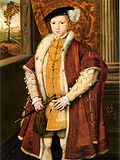Tudor dynasty
The Tudor dynasty was a series of kings and queens of England. Their ancestors were from Wales. This line of rulers started in 1485 and lasted until 1603.
The dynasty started when Henry Tudor defeated Richard III at the Battle of Bosworth Field. This was the final stage of the Wars of the Roses and made him King Henry VII of England. Arthur, Prince of Wales, was the oldest son of Henry VII and Elizabeth of York. He married Catherine of Aragon. She was the daughter of Ferdinand II of Aragon and Isabella I of Castle). Arthur died in 1502 and did not become King.
Henry VIII
When Henry VII died in 1509, Arthur's brother, Henry VIII married Catherine and became king.
During her marriage to Henry VIII, Catherine had six children. Only one of these children, Mary, survived. When Catherine became too old to have any more children, Henry divorced her. He then married a new wife, Anne Boleyn. Henry and Boleyn also had a daughter, Elizabeth. Anne Boleyn was executed in 1536.
Shortly after, Henry VIII married Jane Seymour of England. She had one son, Edward VI of England, who would later become king himself at the age of 9. Jane died in 1537. Her death was caused by medical problems caused by Edward's birth.
Henry married three other wives before his death in 1547. Edward, his only living son, became King after Henry died.
In 1553, Edward became ill. He created the "Device for Succession.". He said that his cousin, Lady Jane Grey, would be Queen after he died. Lady Jane was only queen for nine days.
Henry's daughter, Mary I of England, was the next ruler of the Tudor dynasty. Mary was a strong believer in Catholicism. As Queen, Mary did many things against hundreds of Protestants. Because of all the executions while she was Queen, she was given the nickname "Bloody Mary", which is a name for a modern cocktail today.
After Mary's death in 1558, her half-sister Elizabeth I of England became queen. Unlike Mary, Elizabeth was a Protestant. Elizabeth never married or had children. Because she never married, Elizabeth is often called the "Virgin Queen".
The dynasty ended when Elizabeth died. She had not named a person to be ruler after her death. When she died, James I became King of England. He was the son of Elizabeth's cousin, Mary Stuart. This started the Stuart dynasty.
Religion in England
During the Tudor period, there were many changes in religion. Henry VIII was a Catholic. When the Pope said he could not divorce Catherine, Henry left Catholicism and named himself as head of the Church. The Church of England was now Protestant. Edward VI was raised a Protestant. He closed all Catholic churches. Mary I was a strong Catholic and heavily influenced by her Spanish mother Catherine of Aragon. She closed the Protestant churches and burnt about 300 people for being Protestant. Those people were later called martyrs. Elizabeth was Protestant. When she became queen, the Anglican Church was started.
Rulers of the Tudor dynasty
This is a list of the rulers of the Tudor dynasty:
- Henry VII of England (1485-1509)
- Henry VIII of England (1509-1547)
- Edward VI of England (1547-1553)
- Lady Jane Grey (uncrowned) (1553) (deposed, died 1554)
- Mary I of England (1553-1558)
- Elizabeth I of England (1558-1603)
Tudor Dynasty Media
King Henry VII, the founder of the royal house of Tudor
Henry VIII of England: Henry's quarrels with the Pope led to the creation of the Church of England
Catherine of Aragon: the Church of England annulled her marriage after she failed to produce a male heir to the Tudor dynasty
Thomas Cromwell, 1st Earl of Essex, Henry VIII's chief minister responsible for the Dissolution of the Monasteries
Thomas Cranmer, Henry's first Protestant Archbishop of Canterbury, responsible for the Book of Common Prayer during Edward VI's reign
The title page of Archbishop Cranmer's Book of Common Prayer, 1549
A small boy with a big mind: Edward VI, desperate for a Protestant succession, changed his father's will to allow Lady Jane Grey to become queen
Protestants Hugh Latimer and Nicholas Ridley being burned at the stake during Mary's reign









